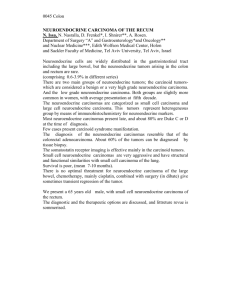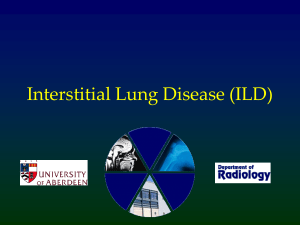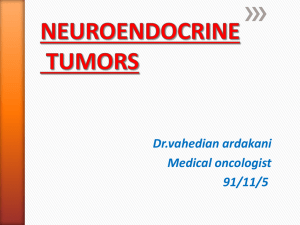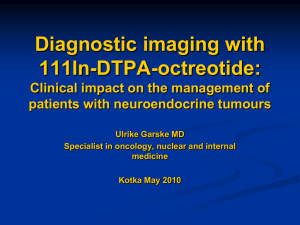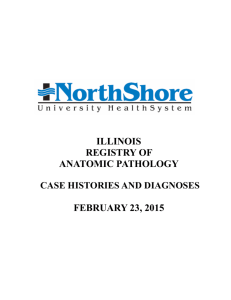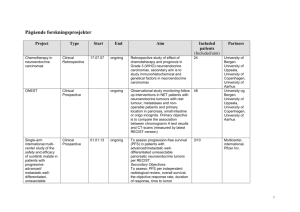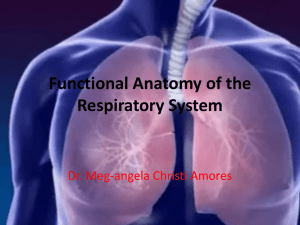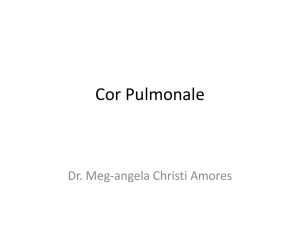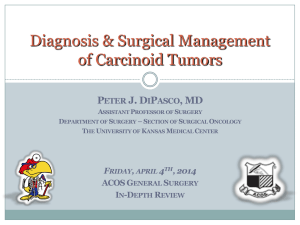Grand Rounds #3
advertisement
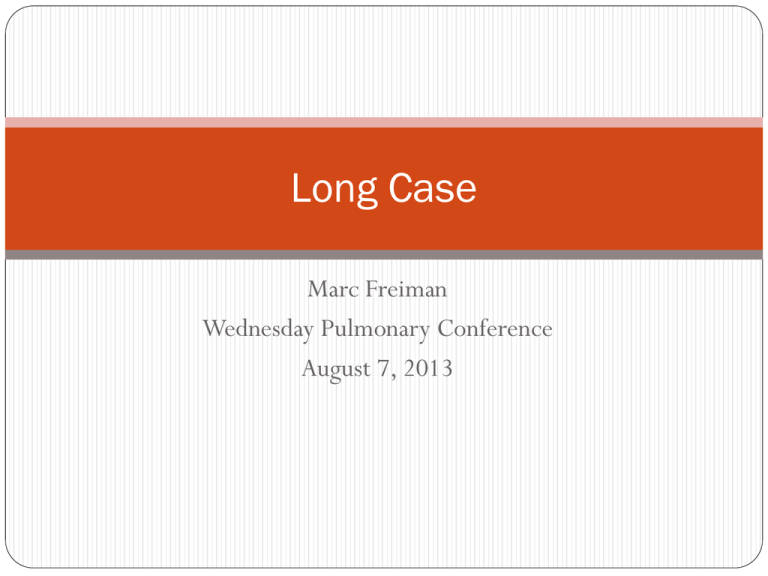
Long Case Marc Freiman Wednesday Pulmonary Conference August 7, 2013 HPI 50 yo woman from the Dominican republic presenting to pulmonary clinic for cough 4-5 years Symptoms may have started after a cold ? Worse in the summer, no temporal relation to night/day Dry, non-productive DOE 2-3 city blocks, 2 flights of stairs ROS - Denies HA, sinus congestion, heartburn, reflux. Denies chest pain, palpitations, orthopnea, PND or edema PMHx/Soc Hx Vitiligo From DR 3 years ago Denies childhood asthma Worked in paper shredding factory for 1 yr Currently works in retail Never smoker No EtOH, illicits Physical exam Afeb P 95 130/84 96% RA; BMI 30 (150lbs, 5’) General: comfortable Clear, no wheeze. ? Crackles at bases bilaterally Neck: supple, no masses, neck nodes not palpable CV: RRR No m/r/g No cervical LAD, neck supple No desaturation on exertion CXR Symptomatic treatment Benadryl Chlorpheniramine Return visit Benadryl lets her sleep through the night Still with continued cough She climbed 3 flights of stairs and became SOB but did not desaturate - minimal sats 96% HR 120 PFT PFT CT Scan CT read LUNGS: There are multiple nodules in both lungs measuring up to 5 mm. Mosaic attenuation is seen in both lungs most prominent in the lower lobes suggestive of small airways or small vessel disease. Labs CBC, Chem 7 wnl ANA, RF negative TTE unremarkable Chronic cough Just kidding… VATS biopsy Had bronchoscopy w BAL VATS biopsy for right lung with RML and RLL biopsy Nodule palpated in RML Bronchoscopy and VATS results Middle lobe lavage cytology negative Aerobic, anaerobic, fungal and AFB cultures negative RIGHT LOWER LOBE BIOPSY: LUNG PARENCHYMA WITH CONGESTION, HEMORRHAGE AND HEMOSIDERIN LADEN MACROPHAGES. NO TUMOR IDENTIFIED. synaptophysin chromogranin RML biopsy IMMUNOHISTOCHEMICAL STUDIES PERFORMED ON PARAFFIN EMBEDDED TISSUE (BLOCK A2) SHOWS POSITIVE STAINING FOR CHROMOGRANIN, SYNAPTOPHYSINMULTIPLE FOCI OF NEUROENDOCRINE TUMOR, TUMORLETS/ SMALL CARCINOID TUMOR. Diffuse idiopathic pulmonary neuroendocrine cell hyperplasia DIPNECH Overview of bronchopulmonary neuroendocrine tumors (BP-NET) 4 types Typical carcinoid Atypical Carcinoid Large cell neuroendocrine carcinoma Small cell neuroendocrine carcinoma Diffuse Idiopathic Pulmonary Endocrine Cell Hyperplasia (DIPNECH) Preneoplastic Pulmonary tumorlets (<5mm) Had been known to occur in: ILD Bronchiolitis obliterans Patients living at high altitudes Purpose of the neuroendocrine cell in the lung? Unknown Arises from Kulchitsky cell Thought to be involved as ‘airway sensors’ Mediate airway tone, pulmonary circulation, and control of breathing. Act as both chemo and mechanoreceptors Also likely involved in development of the lung AJRCCM - demographics Women – 92% (23/25) Mean diagnosis 58 years old Range 36-76 67% non-smokers (16/24) PFTs PFTs 17% 13% 54% Obstructive Restrictive Mixed CT findings Pulmonary nodules (63%, 15 pts) Ground glass (29%, 7 pts) Bronchiectasis (21%, 5 pts) Mosaic attenuation (17%, 4 pts) Clinical course – AJRCCM 2011 92% of patients had symptoms Cough, dyspnea, wheezing Symptoms lasted between days to years – average 8.6 years Widely variable course has been described Not clear exactly why some people deteriorate – known to produce bombesin and fibrinogenic cytokines 41% (7) stable without clinical deterioration Oral predniosne given to 2 of these patients 24% (4) clinically declined and didn’t improve 35% (6) declined but showed improvement clinically Oral prednisone used in addition to bronchodilators in 4 of 6 No deaths 1 patient with asthma history who died of sepsis found to have DIPNECH on autopsy Treatment No formal evaluations of a treatment algorithm are available Resection of dominant lesion Oral/inh steroids w bronchodilators Chemotherapy Surgical lung resection Presence of lymph nodes has not been associated w worse outcome Lung transplantation (1pt, single lung, followed for 2 yrs) Observation ?Somatoastatin analogues Somatostatin-receptor scintigraphy (OctreoScan) Tumors often express somatostatin Labeled somatostatin analog (octreotide) Previously thought to be gold standard for diagnosis Sn approx 80-90% Somatostatin uptake may correspond to treatment response. Somatostatin targeted PET scan Sn as high as 100%, identified more lesions than SRS or CT 111In–DTPA–pentetreotide whole body scintigraphy (Octreoscan) showing an elective uptake of the radiolabeled octreotide in the liver, expression of distant localization of the neuroendocrine tumor of the lung (arrow). Filosso P L et al. Eur J Cardiothorac Surg 2002;21:913-917 © 2002 Elsevier Science B.V. Detail of the Octreoscan showing the liver metastase. Filosso P L et al. Eur J Cardiothorac Surg 2002;21:913-917 © 2002 Elsevier Science B.V. Patient’s octreotide scan No uptake in the lungs Increased uptake in the cecum Negative colonoscopy Further investigation Predisposing factors? ? Hormonal component Tend to be middle-aged females Unclear if race/ethnicity plays a role Incidence? Treatment algorithm? References Ann Oncol (2001) 12 (9): 1295-1300. Davies SJ, Gosney JR, Hansell DM, et al. Diffuse idiopathic pul- monary neuroendocrine cell hyperplasia: an under-recognised spec- trum of disease. Thorax. 2007;62:249-252. Cameron CM, Roberts F, Connell J, Sproule MW. Diffuse idiopathic pulmonary neuroendocrine cell hyperplasia: an unusual cause of cyclical ectopic adrenocorticotrophic syndrome. Br J Radiol. 2011;84:e14-e17. 25. Fessler MB, Cool CD, Miller YE, Schwarz MI, Brown KK. Idio- pathic diffuse hyperplasia of pulmonary neuroendocrine cells in a patient with acromegaly. Respirology. 2004;9:274-277. 26. Pinchot SN, Holen K, Sippel RS, Chen H. Carcinoid tumors. Oncologist. 2008;13:1255-1269. Bronchopulmonary neuroendocrine tumors.Gustafsson BI, Kidd M, Chan A, Malfertheiner MV, Modlin IM Brambilla E, Travis WD, Colby TV, Corrin B, ShimosatoY. The new World Health Organization classification of lung tumours. Eur Respir J. 2001;18:1059-1068. Aubry MC, Thomas CF Jr, Jett JR, Swensen SJ, Myers JL. Signifi- cance of multiple carcinoid tumors and tumorlets in surgical lung specimens: analysis of 28 patients. Chest. 2007;131:1635-1643. Miller RR, Muller NL. Neuroendocrine cell hyperplasia and obliter- ative bronchiolitis in patients with peripheral carcinoid tumors. Am J Surg Pathol. 1995;18:653-658. Sheerin N, Harrison NK, Sheppard MN, Hansell DM,Yacoub M, Clark TJ. Obliterative bronchiolitis caused by multiple tumourlets and microcarcinoids successfully treated by single lung transplanta- tion. Thorax. 1995;50:207-209. Aguayo SM, Miller YE, Waldron JA Jr, et al. Brief report: idiopathic diffuse hyperplasia of pulmonary neuroendocrine cells and airways disease. N Engl J Med 1992;327:1285–8.
